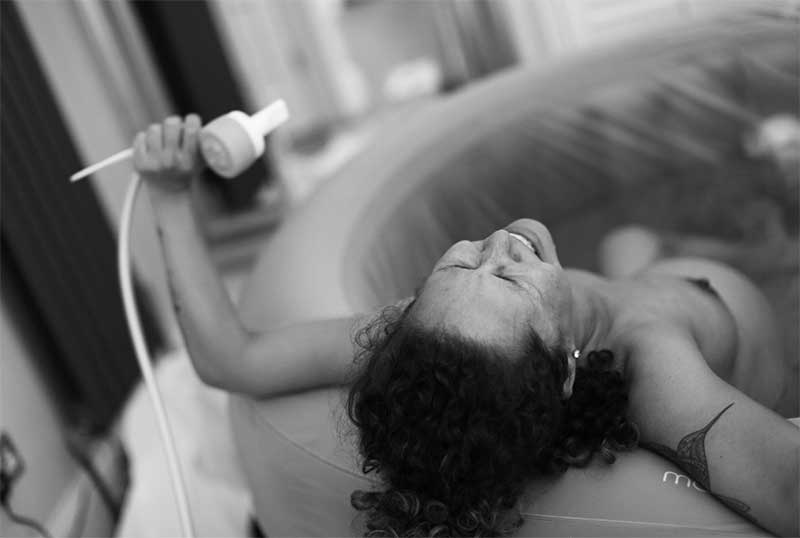How Safe is A Homebirth compared to a Hospital Birth?
With the rapid processing of pregnant Women to get in, through and out of the hospital system quickly, it's no wonder more mothers are considering having a homebirth.
Is a homebirth safe? Will I be alone? What about pain management?
If you have asked yourself these questions, you are in luck! Because once you finished reading this article, you'll have a better understanding of how a homebirth works and you'll feel more confident to make an informed decision.
So, who better to discuss having a homebirth than Midwife and breastfeeding expert Dr Robyn Thompson? A grandmother herself, who had more than 50 years experience, 25 of those she spent as a homebirth Midwife.
Dr Robyn Thompson founder of The Thompson Method, answers some of the most common questions surrounding having a homebirth.
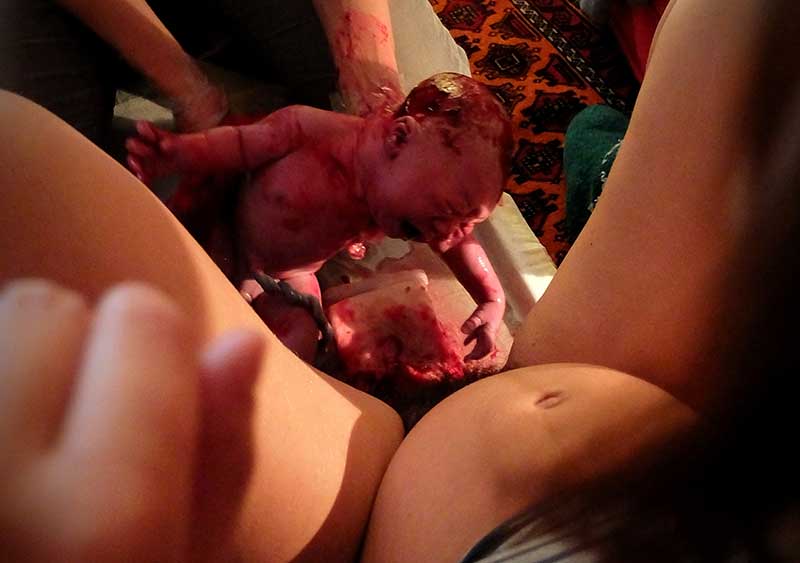
Are there any risks with having a homebirth?
When considering a homebirth, the question of safety often arises, "It's not safe, especially for a first time mother!"
So, is a homebirth safe?
Dr Robyn Thompson says, in her experience as a midwife for 50 years, yes it is!
For over 25 years Dr Robyn worked with hundreds and hundreds of women who chose to give birth to their babies at home.
With the number of women being herded in, through and out of the hospital system and intervention rates increasing phenomenally and all the things that are done to women and their bodies, that is not done at home, a homebirth with an experienced homebirth Midwife, practised safely is safe.
An experienced home birth Midwife carries a kit with her, which is equivalent to a small labor ward kit, that you would have in the hospital room with you.
Homebirth Midwives have homebirth supplies. They can put drips up if required, they can look after bleeding, they can speak with the paramedics, they can transfer to a hospital if required. However, in Australia (and other countries around the world) there are more and more restrictions being added, including which hospital you can be transferred to, so it's best to do your own research in your local area.
But as expected of the professional midwife, no one can predict exactly what will happen, which is why it's important to have an experienced midwife who will be prepared for unexpected situations.
A Woman may feel very safe in her own surroundings.
Women choose who they want around them as well. Dr Robyn says, "We need to remember that we are entering their home that we are visitors in their home. We do not take over their home and everything about them in that home but we do the very best to achieve what is expected of the reasonable midwife."
Every single birth is completely unique and irrelevant whether it's your first, second, third or eighth baby. Each journey will be unique in their own way anyway.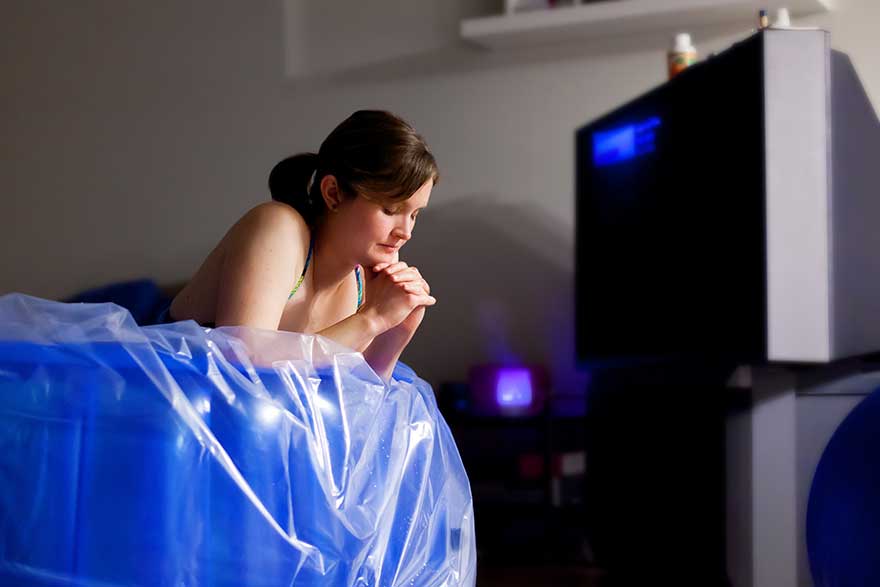
Pic: A Woman may feel very safe in her own surroundings.
Being monitored when you choose to birth at home
Many women believe or are concerned that they won't be monitored at home.
Dr Robyn states, "Well I've always carried a handheld doppler with me. And that little doppler can be turned down so it's not loud and the readout can be seen, so that you can see the range of the baby's heart rate, because it does range."
A baby's heart rate does not stay the same all of the time. And so the baby progresses with the mother through the labour, through the hip and pelvis, negotiating, moulding the head angles, and the different shapes that the little baby has to manoeuvre through,. And because of this, babies heart rates do change.
It's how they recover, that's important to know so an experienced midwife will be listening to those things with the Mother's consent.
And of course the Mother wants to hear her baby's heart rate as long as we don't have it thumping loud, it's about being discreet and giving her the best opportunity for the quiet time she needs in the space that she needs as well.
And that's where home birthing can be a huge benefit.
Handheld doppler also referred to as a pinard stethoscope
What if there's an emergency before, during or after childbirth?
Dr Robyn says, "It's important to be wise."
Midwives do have to be on the alert because if things do indicate that there may be something that needs to be dealt with, it depends on what that might be at any one point in time, it's a matter of recognising those signs and knowing what to do, calmly in the moment."
Midwives are a very educated profession. They are proficient in their own right. They do not need to conform to medical control. In an ideal world, they participate in complementary discussion and complementary work with their medical colleagues.
Dr Robyn has worked with many of her medical colleagues over her career, and says it's absolutely delightful to be able to be in a partnership with a woman who does not feel left out at any stage.
Sadly, we find that quite lacking in the women's stories. Based on the stories that women are sharing now, there appears to be a real void in what's happening with women, even more so in the [hospital] institution now more than ever.
"I think that women will know whether they want to be at home or whether they'd prefer the hospital."
For some women, distance from a hospital is an important factor in the decision making.
It depends how far a woman has to travel because it's preferable not to have your baby on the road on the way, on the highway. A rapid delivery and rapid birth with the baby descending quickly. If a woman is not close to a hospital, sometimes it may be better to stay at home and hopefully, someone can come but that's not always the way unless it's well planned.
So again, there's a whole lot of factors around it that can change for each unique woman, what might be her plan, or something that she didn't expect.
"What if I'm at home and labouring & change my mind?"
This is quite a common question.
Dr Robyn says, "That's okay because if we're planning well with a woman, and we're listening to what she's saying, if she does change her mind, we have a backup system available and ready."
"We do not deliver babies. Women give birth to their baby. It's her birth."
"The only time we may assist a woman with a delivery is when it's necessary, but we don't deliver babies, we actually to give the glory back to the mother, it's hers."
In the past, midwives have been very well respected, no hassles, no restrictions whatsoever.
"Midwives were welcomed into the hospital and so once you got there, you're included you were not cut off which was brilliant because, you know I've been with a woman for however long throughout her pregnancy, why would they want to cut me off? "
Again, the communication needs to be inclusive with the health professional complementary services.
So I was very lucky to have that sort of thing available but I'm not sure that's working as well now, and for a lot of factors, but I do believe that we need to rethink. We need to re establish how we're thinking and what are the benefits for a woman. What are her benefits not our benefits.
A woman labors at home
After birth care for a Mother and baby of a homebirth
Women want to know if it's the same with homebirth labor. Does the midwife disappear as soon as they've given birth? What about after birth care for themselves?
Dr Robyn Thompson
After birth, often refers to the placenta. So if we talk about the placenta, about postpartum time. Generally I'm referring to the placenta birth, possible vaccinations that they may have and other medical interventions, and of course the first breastfeed, and those few hours after that.
So I work with women on the basis that it's how her birth has been, and how she feels. But, if possible, not to separate from her baby. That's probably one of my most important principles. The first 3 golden hours are a time where the mother and the baby have time together, providing the baby's Apgar score is seven or above.
The baby is with the mother where it should be. The baby has just come from the mother's uterus, so it should be with her right there. Not with someone else, unnecessarily. Routine procedures can wait. They are not urgent. They are for ticking boxes to say they have been done.
So I think ticking boxes needs to be reconsidered and the respect given back to the woman that this is her time, not our time, and those sorts of things, can be done when appropriate and when the mother agrees.
Checkout this beautiful homebirth story from a first time Mother
How important is the first breastfeed?
So, a mother has given birth at home, and it's her wish to breastfeed her baby. How does a homebirth benefit her breastfeeding experience?
Dr Robyn Thompson
The little baby should be with its mother, locating the breast, in its own good time but many people (particularly in the hospital system) expect the baby to do this within an hour.
It depends on the unique baby, whether the mother's had opiates, those babies may be sleepy. It depends on the history, it depends on the story that's happened really. So you're going moment by moment, and then it's really important to not to rush.
There's no need to rush when you're in your own home.
The mother needs time. The baby needs time for the instinctive skills, for the small brain to create the coordination that's necessary to make its way to the breast. And then they feed at their leisure, not rapidly not hurried not shoved out of the room and corridor in a chair. They have that piece of time. It's very, very important.
The baby will feed frequently from both breasts. Under most circumstances. Not always. And draw down the colostrum, which prepares the newborn gut for the rest of its life. The microbes that are coming through that colostrum into that little baby's digestive system is phenomenal. So we need to always as much as possible, encourage, and make sure that we facilitate that.
Click here to learn more about the 3 Golden Hours
Explore The Breastfeeding Course →
What are more benefits of a homebirth?
You talk about being calm and patient and allowing the mother and baby to lead in their own journey but how does a homebirth encourage that?
Dr Robyn Thompson
Well, a mother takes, depending on the circumstances, the mother takes her own baby. We don't actually take her baby. She holds her own baby she decides when she wants to separate the cord and the placenta. It depends on the circumstances entirely at the time. There's the preparation during pregnancy that's very important.
You want to observe the colour of the baby's lips. You see the baby pinking up once they take their first breath. Baby's born, particularly through water actually don't breathe straightaway. They're very calm, and they take that time that's required to take that first breath. And it's really beautiful to see that, and then some of the mothers who've had a baby before or several before say our baby's not crying now there is a difference.
So the transition through the water seems to be beautiful. Again, it's not always perfect because you know I have had to help unravel a little baby who was rounding cord through the water and that worked beautifully, but again it's always in the moment.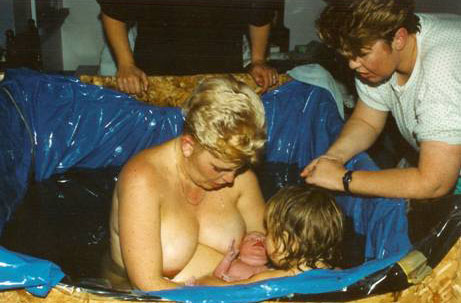
Dr Robyn Thompson observing woman who has just given brrth at home
Mothers don't do anything wrong. It's the way we go about business that's wrong.
Our professional role is not to make you feel like you're doing something wrong. We can make suggestions that might help. But I don't believe we have any right to say anything that makes you feel as though you're doing something wrong.
We guide you gently, we advise you sometimes if we feel it's really important, but most of the time we make suggestions. And you know that's my way anyway. And I am thankful for the women that have given me the environments to be in that I could see this unfolding.
You know, we're the only mammals except for the mammals in the zoo that, allows anybody to takes our babies from the mother unnecessarily. We shouldn't be doing that. You see I'm passionate about that!
What about home birth after a C-Section?
If a Woman is preparing for a homebirth after a C-Section, are there any additional considerations?
Dr Robyn Thompson
Well that's a unique situation. It's a unique journey through your pregnancy. It's a unique journey into your baby settling into your pelvis, your early labour, into established labour. All of that is unique for you when choosing a home birth experience.
I have worked with many women who had a previous Caesarean section who gave birth to their baby at home, and one was a 10 and a half pound baby and she did it beautifully.
But I'm not saying everybody can do that.
The mother prepares for it in pregnancy, preferably, that would be my suggestion.
She prepares for it, she works towards it, and she keeps an open mind, and continues to keep an open mind, and we're keeping an open mind with her. Then the opportunities to do whatever she needs at any one point in time, are there, and that's really really important.
You know, not to have everybody believe that they can do this, because not everybody is the same. And so we can't give you a 100% guarantee we cannot give you a 100% answer.
But we do our very best to help you achieve what your goals are.
What are alternatives to pain relief, and managing pain at home?
What are some of the homebirth options that Women can consider to help her manage pain during labor at home? Are there any recommended supplies for homebirth?
Dr Robyn Thompson
Well, for me, most of the women I worked with had their own plan for their own pain relief and most of that time would be in the water, where they're buoyant. When they're buoyant that releases the tension of the muscles and the nerve endings and they can move more freely in the water because that's their own space.
That was one big thing, when the woman immerses in the water you can just see her facial expression changing. I have some beautiful photographs of that.
There are water injections over the area that's most painful for the woman, and then by just, you know, very very slightly under the skin, not deep, no needles deep, very slightly create a little bubble that relieves nerve ending pain between the skin.. It helps to block the pain to the gateway of the brain. And of course midwives are educated to do that.
I've got to say that if you can avoid epidural then that protects your baby from the effects of the opioids. It also protects you from the effects of the opioids, but if you do need anaesthetics for a valid reason, or you do need surgery, of course you need those drugs to help you through that time.
So it's not about one thing fixes all and there's people who have their own Tens machine, there's a whole range of things that can be done. All the things for each individual, unique woman and she feels best with what's right for her.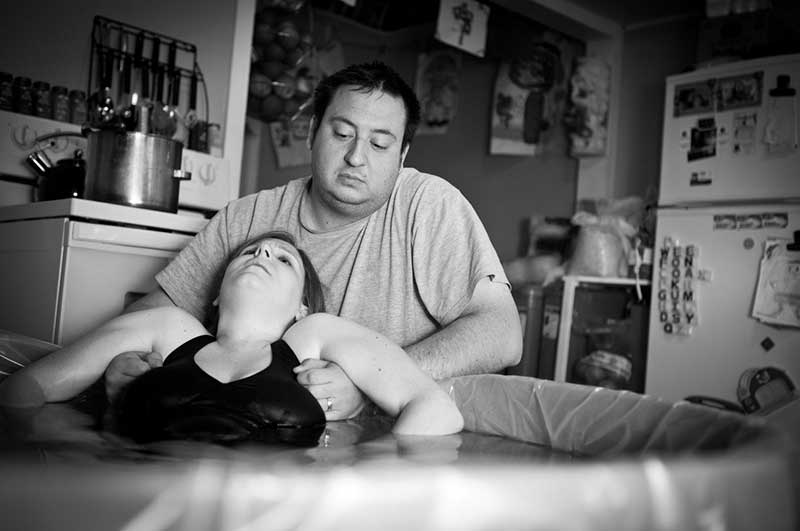
A women in labor immerses herself in water.
Learn and exercise your rights
Dr Robyn Thompson encourages Women to always do their own research and look into what their own country's laws are on pregnancy, labor and birth. This includes understanding your country’s laws in relation to homebirth.
It always depends on where you're based in the world as to what laws and policies are in place in that country. Dr Robyn gently reminds us to understand that hospital policy is NOT law.
Dr Robyn Thompson
If you're practising responsibly and you're accountable for your actions, you're providing a duty of care which is expected and respecting that women know their rights. They know that they have the legal right to consent.
Of course, in event of a hospital transfer, the senior medical personnel will make decisions in case of an urgent or emergency situation, but you know with a healthy mother and baby with an Apgar score of 7 or above, it's preferable to avoid unnecessary medical intervention.
We do not stand over these Women, we do not dominate them. We move with them in their rhythm, not over them. We talk with them gently and quietly with them. We do not give orders and instructions.
We are gentle. We are calm and we listen to the baby and we listen to the mother, and we do our job and fulfil it to the highest possible quality that we can.
How can I create my own homebirth plan?
There's a lot to take on board when considering your unique birth plan. Having a birth plan, exploring your wishes , communicating those wishes, and including breastfeeding in that plan. Maybe you want to consider a water birth. It can be so overwhelming.
Dr Robyn, you talk about the importance of having a birth plan and including breastfeeding in that plan. Is this key to a successful breastfeeding journey?
Dr Robyn Thompson
Yes, in my birth plan template women can take whatever they feel is important to them and communicate it effectively. I've included the warnings and the information in it for the women to be aware of.
It's very important that the template is not regarded as a birth plan for every mother, because that's not right. It's a template that explains a whole lot of things that helps the woman have the knowledge.
The woman goes with the knowledge and she works on her own unique situation. And also she knows her rights so she can have discussions with people about things that she agrees with or things that she may not want right now or things that she doesn't agree with.
Check out 5 Key Factors to Include in Your Birth Plan

Can I have a homebirth if I my pregnancy is considered 'geriatric'?
Dr Robyn Thompson
I have been with a mother at 45 and she did very well, beautifully so again I can't give you a definitive answer, that would be for you as it depends on your circumstances and how you've progressed through your pregnancy.
However, yes, by all means you can make your choices as you go along, it doesn't have to be rigid and I think that's the big problem. It's the fear that we generate by coercion and rigidity. It's about being flexible to see how things go for you.
What are some Homebirth options and positions?
Dr Robyn Thompson
There are some women who choose not to have a pool at home and that's okay, that's fine. I've had one woman who chose her spot on her beautiful bedroom floor with it all covered and doing what she needed to do. Another one on her back balcony.
Another one in front of her fire in the winter. So, the warmth radiating from the fire was, of course, protected, but that's where they chose to be so you do not have to be in a pool if you don't want to be. You can, if you need to use water you can use the shower, you may not need to use anything you might be walking.
It's different for everybody, but you know a little bit of hip movement is great because that helps the baby negotiate through the pelvis.
There is a doctor in Brazil that actually dances with the women and I think that's magic because it keeps our bodies in the mobile situation, preferably not on a bed. Preferably off a bed because that flattens the sacrum and the sacrum can't rise and the diameter in the pelvis is reduced when you're laying flat on your back.
And if someone does need to give birth, in a reclining position or a laid back position, it's called McRoberts Position, that can sometimes be very helpful but not with someone standing over you, directing you to push!
No way. It's what you do in your good time.
In my experience, an upright position works best because you have gravity working with you and you have movement. Whatever is right for the woman.
A lot of women when they're really getting close will start to make a sound, then their knees will bend. They'll make another sound at the peak of a contraction, which gradually increases till they've gone to hands and knees on the floor. Many women will do that and that's the way it just happens for them. No rules.
In Dr Robyn's experience an upright position works best.
Tips to reduce the risk of tearing
Dr Robyn Thompson
In my experience, the Women who were instructed when to push, that's when their perineal muscle is stretched beyond capacity too quick.
So, if you can do it, gently in your own good time without someone instructing you, that's where we get into your rhythm. This can be done quietly, not loudly and not above you.
We work with you very quietly to encourage you in your rhythm, and let that perineal muscle stretch, stretch, stretch.
The perineal muscle stretches eight different ways.
It's a very flexible muscle and I believe if I've got it right, correct me if I'm wrong, that it's the only muscle in the body that goes that many directions, so it's not meant to be forced open.
It's not meant to be ripped by a hard pull with forceps because soft tissue tears, and we try to avoid tears, if we can. By working with the woman in the moment, as long as the mother and baby is safe.
My final thoughts: Is a homebirth for you?
What an interview! Afterwards I found myself feeling empowered and really educated about the safety of homebirth.
So, if you are considering a homebirth or hospital birth, these questions and the detailed responses from Dr Robyn Thompson should absolutely help you to come to a decision based on your unique situation.
I hope you feel more confident in your choices now and go away looking to be armed with knowledge about birth and breastfeeding.
If you're looking for more homebirth information or you're looking for a homebirth midwife, you may find the below resources helpful:
American Pregnancy Association - Homebirth
Midwifery UK - Homebirth in the UK
Homebirth Aotearoa - Homebirth in New Zealand
I wish you all the best in your birth and breastfeeding journey.
Chelsea Kerley - UK Journalist & Mother
If you've found this blog post and Dr Robyn's live interview on '5 Key Factors to Include in your Birth Plan'
You may like to join our free Facebook Group to learn more about what's possible with the Thompson Method for your birth and breastfeeding journey.
If you are interested in find out more about The Thompson Method Breastfeeding Course click here
And of course, click the video about if you'd like to watch the full interview.
From all of us at The Thompson Method team, happy birthing & happy breastfeeding.
♡ ♡ ♡ ♡ ♡ ♡ ♡ ♡ ♡ ♡ ♡ ♡ ♡ ♡ ♡

